An Alternative Method of Obtaining the Particle Size Distribution of Soils by Electrical Conductivity
Abstract
1. Introduction
2. Materials
2.1. Properties of Soils
2.2. Dispersion Agent
2.3. Hydrometer Approach for Validation
2.4. Laser Diffraction Technique for Validation
2.5. Newly Developed Electrical Conductivity Probe
3. Methods
3.1. Theory and Mathematical Formulation
3.2. EC Approach with Sedimentation
3.3. Effective Distance Measurement
3.4. Experimental Programmes
3.4.1. Pre-Treatment Steps
- i.
- About 25 g of oven-dried soil was weighed accurately with a balance and transferred to a glass beaker. The glass beaker was washed properly with distilled water before the commencement of the test.
- ii.
- The soil was then subject to chemical pre-treatments, which were performed in two stages, namely organic material removal and calcium compound elimination. First, the soil was pre-treated with a hydrogen peroxide (H2O2) solution (20 volume) to remove the organic matter at a rate of 1 mL/g of the sample (Figure A1a). Then, the mixture was kept steady to allow oxidation to take place. Hydrogen peroxide caused oxidation of the organic matter, and a small amount of gas was generated (Figure A1b). The mixture was kept steady for 10–15 min until no more bubbles appeared. After this, the mixture was sieved with a 75 μm sieve. If less concentrated hydrogen peroxide is used, the mixture will require heating with a Bunsen burner, with a temperature not exceeding 600 °C.
- iii.
- The soil remaining from step (ii) was transferred to another clean glass beaker. To remove the calcium compounds, 0.2 M hydrochloric acid (HCl) was added to the soil at a rate of 1 mL/g soil (Figure A1c). When the reaction ended, the mixture was filtered again. The filtrate was washed properly with distilled water until it was completely free from the acid. The damp soil was transferred to an evaporating dish. Both the damp and filtrated soils were oven-dried overnight, and their mass was recorded.
- iv.
- The next day, the oven-dried pre-treated soils were transferred to a clean beaker.
- v.
- The mixture was then stirred vigorously for 30 min using a mechanical stirrer. The contents of the mixture were then transferred to the cup of a mechanical stirrer. The cup should not be filled to more than ¾, as the turbulence created by the rotating blade may cause the mixture to spill out of the cup. Stirring time may vary based on the soil properties. For more clayey soils, the stirring period should be increased.
- vi.
- The suspension was washed through the 75 μm sieve again using distilled water. The portion which passed through the sieve was taken for the experiment. The specimen was washed in a cylindrical 1000 mL glass jar and adequate water was added to make 1000 mL of suspension. After this, the whole suspension was mixed properly to ensure homogeneity.
- vii.
- The cylindrical glass jar was then kept inside a water tank which had a temperature-controlling motor. The whole experiment was conducted inside the water tank so that the temperature did not affect the conductivity value.
3.4.2. Calibration by EC for PSD Analysis
3.4.3. Correction of EC Values in Calibration
3.4.4. Steps of EC Measurement
- I.
- A 1 L suspension with 25 g of soil was prepared as described before. To ensure homogeneity, the palm of a hand on the open end of the sedimentation beaker was placed to turn it upside down and back repeatedly a few times.
- II.
- A stopwatch was started to record the time. The first reading was taken at t = 1 min
- III.
- The recording of EC changes continued by considering a 5 min interval. Not all the changes will be important for the PSD analysis. However, the operator can skip a measured point if the difference is marginal.
- IV.
- The experiment ends at t = 120 min. The measured EC values on the spreadsheet are then compared with the calibrated density values. If any specific EC value is not matched with the calibrated density values, then either the closest value in the calibration or the equation through the 3-point calibration can be used.
- V.
- The final PSD curve is then obtained. The experimental time can be extended if only 50% of passing soil particles are obtained. However, this situation will be unlikely since the sedimentation process was not interrupted.
- VI.
- After the completion of each test, the beaker was removed from the water tank and cleaned properly with de-ionised water. Before starting the experiment with the next sample, all of the tools were cleaned and dried out appropriately to avoid contamination in the samples.
4. Results
4.1. Particle Size Distribution by Electrical Conductivity
4.2. Accuracy Assessment
4.3. Reproducibility of Results
5. Discussion
5.1. Advantages of Present Approach
5.2. Insensitivity to Types of Soils
5.3. Analysis of the Efficiency of the Approach
5.4. Factors Affecting the Accuracy
5.5. Limitations and Future Recommendations
6. Conclusions
Author Contributions
Funding
Data Availability Statement
Acknowledgments
Conflicts of Interest
Appendix A

References
- Liu, D.; O’Sullivan, C.; Carraro, J.A.H. The Influence of Particle Size Distribution on the Stress Distribution in Granular Materials. Géotechnique 2023, 73, 250–264. [Google Scholar] [CrossRef]
- Ma, S.; Song, Y.; Liu, J.; Kang, X.; Yue, Z.Q. Extended Wet Sieving Method for Determination of Complete Particle Size Distribution of General Soils. J. Rock Mech. Geotech. Eng. 2024, 16, 242–257. [Google Scholar] [CrossRef]
- Yang, Y.; Jaber, M.; Michot, L.J.; Rigaud, B.; Walter, P.; Laporte, L.; Zhang, K.; Liu, Q. Analysis of the Microstructure and Morphology of Disordered Kaolinite Based on the Particle Size Distribution. Appl. Clay Sci. 2023, 232, 106801. [Google Scholar] [CrossRef]
- Hasan, M.F. Electrical Conductivity of Saturated Fine-Grained Soils: Modelling and Soil Classification Applications. Ph.D. Thesis, La Trobe, Melbourne, Australia, 2020. Available online: https://opal.latrobe.edu.au/articles/thesis/Electrical_Conductivity_of_Saturated_Fine-Grained_Soils_Modelling_and_Soil_Classification_Applications/14227487 (accessed on 21 May 2024).
- Wei, Y.; Wu, X.; Cai, C. Splash Erosion of Clay–Sand Mixtures and Its Relationship with Soil Physical Properties: The Effects of Particle Size Distribution on Soil Structure. Catena 2015, 135, 254–262. [Google Scholar] [CrossRef]
- Bouyoucos, G.J. Hydrometer Method Improved for Making Particle Size Analyses of Soils. Agron. J. 1962, 54, 464–465. [Google Scholar] [CrossRef]
- Gee, G.W.; Bauder, J.W. Particle Size Analysis by Hydrometer: A Simplified Method for Routine Textural Analysis and a Sensitivity Test of Measurement Parameters. Soil Sc. Soc. Am. J. 1979, 43, 1004–1007. [Google Scholar] [CrossRef]
- Beuselinck, L.; Govers, G.; Poesen, J.; Degraer, G.; Froyen, L. Grain-Size Analysis by Laser Diffractometry: Comparison with the Sieve-Pipette Method. Catena 1998, 32, 193–208. [Google Scholar] [CrossRef]
- ASTM D422 63; Standard Test Method for Particle-Size Analysis of Soils. ASTM International: West Conshohocken, PA, USA, 2017.
- Eshel, G.; Levy, G.J.; Mingelgrin, U.; Singer, M.J. Critical Evaluation of the Use of Laser Diffraction for Particle-Size Distribution Analysis. Soil Sci. Soc. Am. J. 2004, 68, 736–743. [Google Scholar]
- Bittelli, M.; Pellegrini, S.; Olmi, R.; Andrenelli, M.C.; Simonetti, G.; Borrelli, E.; Morari, F. Experimental Evidence of Laser Diffraction Accuracy for Particle Size Analysis. Geoderma 2022, 409, 115627. [Google Scholar] [CrossRef]
- Magno, M.C.; Venti, F.; Bergamin, L.; Gaglianone, G.; Pierfranceschi, G.; Romano, E. A Comparison between Laser Granulometer and Sedigraph in Grain Size Analysis of Marine Sediments. Measurement 2018, 128, 231–236. [Google Scholar] [CrossRef]
- Milligan, T.G.; Law, B.A.; Zions, V.; Hill, P.S.; Hua, K.; McKindsey, C.W.; Lacoursière-Roussel, A. Reconciling Coulter Counter and Laser Diffraction Particle Size Analysis for Aquaculture Monitoring. Environ. Monit. Assess. 2024, 196, 672. [Google Scholar] [CrossRef] [PubMed]
- Shang, Y.; Kaakinen, A.; Beets, C.J.; Prins, M.A. Aeolian silt transport processes as fingerprinted by dynamic image analysis of the grain size and shape characteristics of Chinese loess and Red Clay deposits. Sediment. Geol. 2018, 375, 36–48. [Google Scholar] [CrossRef]
- Zheng, J.; Hryciw, R.D. Soil particle size and shape distributions by stereophotography and image analysis. Geotechn. Test. J. 2017, 40, 317–328. [Google Scholar] [CrossRef]
- Jones, R.B. Rotational Diffusion of a Tracer Colloid Particle: I. Short Time Orientational Correlations. Phys. A Stat. Mech. Appl. 1988, 150, 339–356. [Google Scholar] [CrossRef]
- Dapkunas, S.J.; Jillavenkatesa, A.; Lum, L.H. Particle Size Characterization. In NIST Recommended Practice Guide, SP 2001; NIST: Gaithersburg, MD, USA, 2001; pp. 960–961. [Google Scholar]
- Sochan, A.; Bieganowski, A.; Bartmiński, P.; Ryżak, M.; Brzezińska, M.; Dębicki, R.; Stuczyński, T.; Polakowski, C. Use of the Laser Diffraction Method for Assessment of the Pipette Method. Soil Sci. Soc. Am. J. 2015, 79, 37–42. [Google Scholar] [CrossRef]
- Taubner, H.; Roth, B.; Tippkötter, R. Determination of Soil Texture: Comparison of the Sedimentation Method and the Laser-diffraction Analysis. Z. Pflanzenernähr. Bodenk. 2009, 172, 161–171. [Google Scholar] [CrossRef]
- Durner, W.; Iden, S.C.; Von Unold, G. The Integral Suspension Pressure Method (ISP) for Precise Particle-size Analysis by Gravitational Sedimentation. Water Res. Res. 2017, 53, 33–48. [Google Scholar] [CrossRef]
- Zhang, X.; Warren, C.J.; Spiers, G.; Voroney, P. Comparison of the Integral Suspension Pressure (ISP) and the Hydrometer Methods for Soil Particle Size Analysis. Geoderma 2024, 442, 116792. [Google Scholar] [CrossRef]
- Allen, T. Particle Size Measurement; Springer: Berlin/Heidelberg, Germany, 2013; Available online: https://books.google.com/books?hl=en&lr=&id=7dsFCAAAQBAJ&oi=fnd&pg=PR17&dq=Allen,+T.+(2013).+Particle+size+measurement.+Springer.&ots=SnhnPMps_i&sig=qm9TQ-2KfrtAkhjhOJ69vpCDt5o (accessed on 21 May 2024).
- Messing, I.; Soriano, A.M.M.; Svensson, D.N.; Barron, J. Variability and Compatibility in Determining Soil Particle Size Distribution by Sieving, Sedimentation and Laser Diffraction Methods. Soil Tillage Res. 2024, 238, 105987. [Google Scholar] [CrossRef]
- Hasan, M.F.; Abuel-Naga, H. Determining Liquid Limit and Plastic Limit of Clay Soils by Electrical Surface Conduction and Diffuse Double Layer Thickness. Minerals 2024, 14, 210. [Google Scholar] [CrossRef]
- Choo, H.; Park, J.; Do, T.T.; Lee, C. Estimating the Electrical Conductivity of Clayey Soils with Varying Mineralogy Using the Index Properties of Soils. Appl. Clay Sci. 2022, 217, 106388. [Google Scholar] [CrossRef]
- Hasan, M.F.; Abuel-Naga, H. Effect of Temperature and Water Salinity on Electrical Surface Conduction of Clay Particles. Minerals 2023, 13, 1110. [Google Scholar] [CrossRef]
- Oh, T.-M.; Cho, G.-C.; Lee, C. Effect of Soil Mineralogy and Pore-Water Chemistry on the Electrical Resistivity of Saturated Soils. J. Geotech. Geoenviron. Eng. 2014, 140, 06014012. [Google Scholar] [CrossRef]
- Day, P.R. Physical Basis of Particle Size Analysis by the Hydrometer Method. Soil Sci. 1950, 70, 363–374. [Google Scholar] [CrossRef]
- Arora, K.R. Soil Mechanics and Foundation Engineering: In SI Units; Standard Publishers Distributors: New Delhi, India, 2000. [Google Scholar]
- Head, K.H. Manual of Soil Laboratory Testing; Pentech Press: London, UK, 1980; Volume 1, Available online: http://www.whittlespublishing.com/userfiles/shop/errata/198.pdf (accessed on 21 May 2024).
- Lucena, P.G.; Aquino, R.V.; Sousa, J.E.; Júnior, V.S.S.; Pacheco Filho, J.G.; Pereira, C.F. Mineral and Particle-Size Chemometric Classification Using Handheld near-Infrared Instruments for Soil in Northeast Brazil. Geoderm. Reg. 2024, 38, e00819. [Google Scholar] [CrossRef]
- Feynman, R.P.; Leighton, R.B.; Sands, M.; Hafner, E.M. The Feynman Lectures on Physics; Vol. I. Am. J. Phys. 1965, 33, 750–752. [Google Scholar] [CrossRef]
- Maxwell, J.C. VIII. A dynamical theory of the electromagnetic field. Phil. Trans. R. Soc. 1865, 155, 459–512. [Google Scholar]
- Gee, G.W.; Bauder, J.W. Particle-Size Analysis. In SSSA Book Series; Klute, A., Ed.; Soil Science Society of America, American Society of Agronomy: Madison, WI, USA, 2018; pp. 383–411. [Google Scholar]
- Polakowski, C.; Ryżak, M.; Sochan, A.; Beczek, M.; Mazur, R.; Bieganowski, A. Particle Size Distribution of Various Soil Materials Measured by Laser Diffraction—The Problem of Reproducibility. Minerals 2021, 11, 465. [Google Scholar] [CrossRef]
- Murad, M.O.F.; Jones, E.J.; Minasny, B. Automated Soil Particle-size Analysis Using Time of Flight Distance Ranging Sensor. Soil Sci. Soc. Am. J. 2020, 84, 690–699. [Google Scholar] [CrossRef]
- Polakowski, C.; Sochan, A.; Bieganowski, A.; Ryzak, M.; Foldenyi, R.; Toth, J. Influence of the Sand Particle Shape on Particle Size Distribution Measured by Laser Diffraction Method. Int. Agrophys. 2014, 28, 195–200. [Google Scholar] [CrossRef]
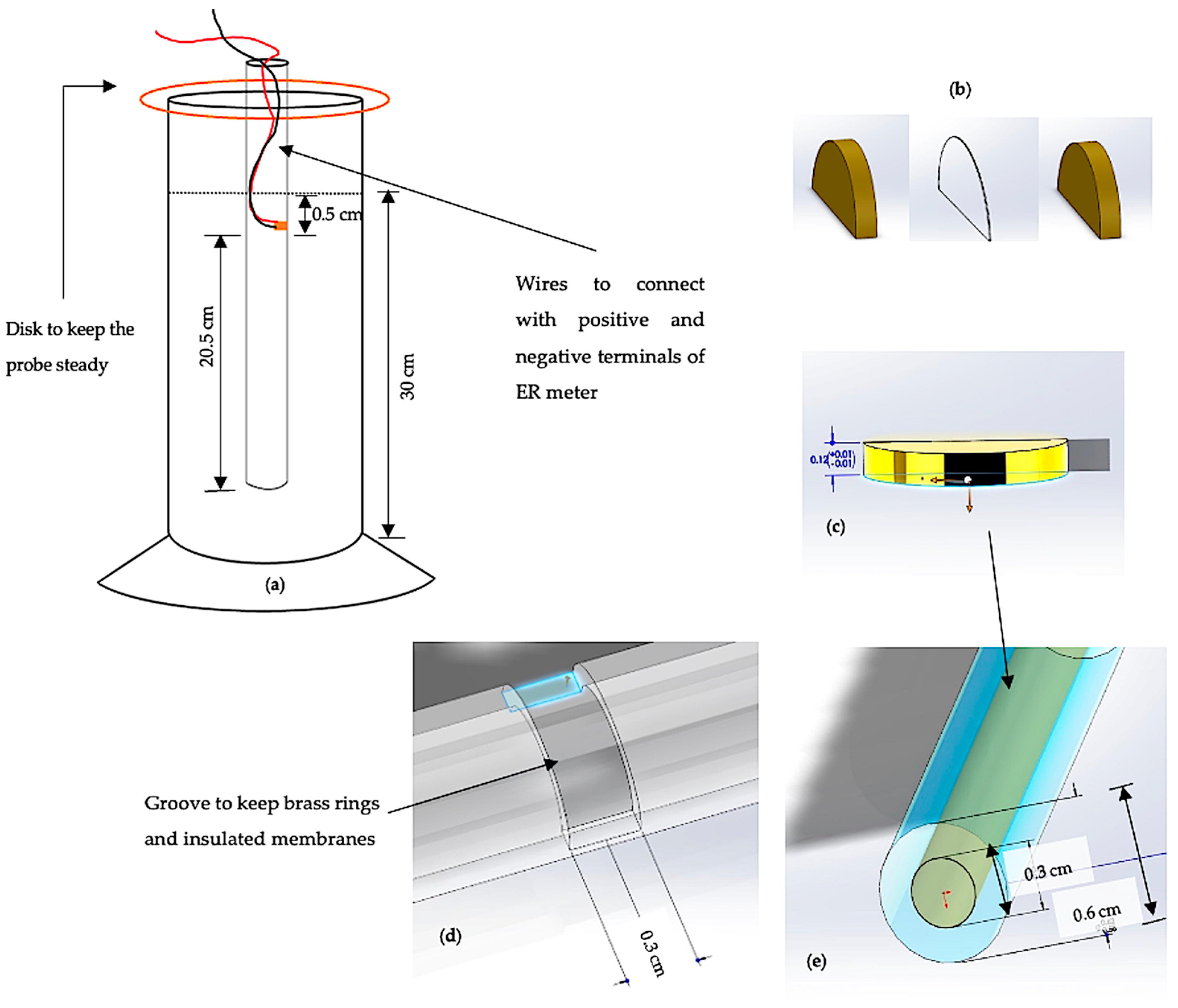



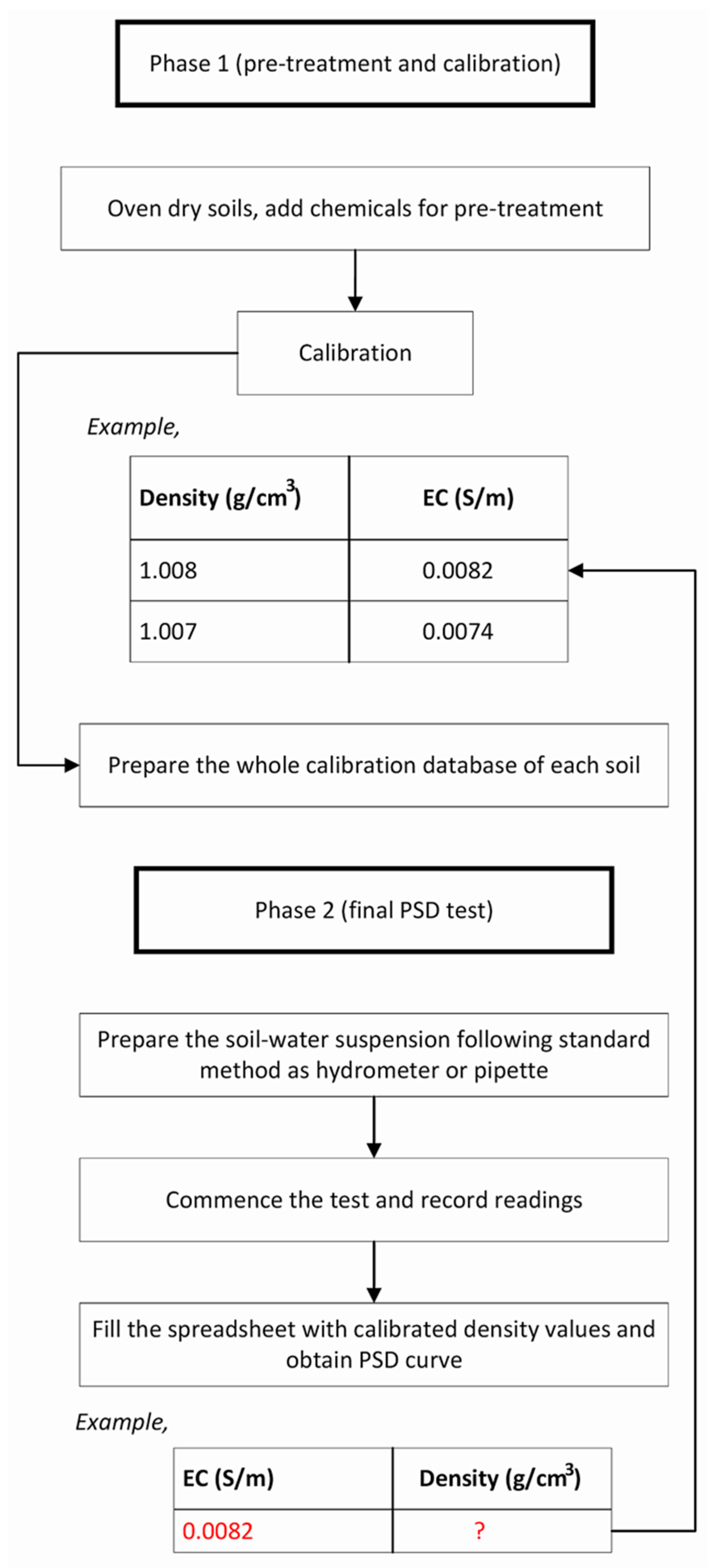
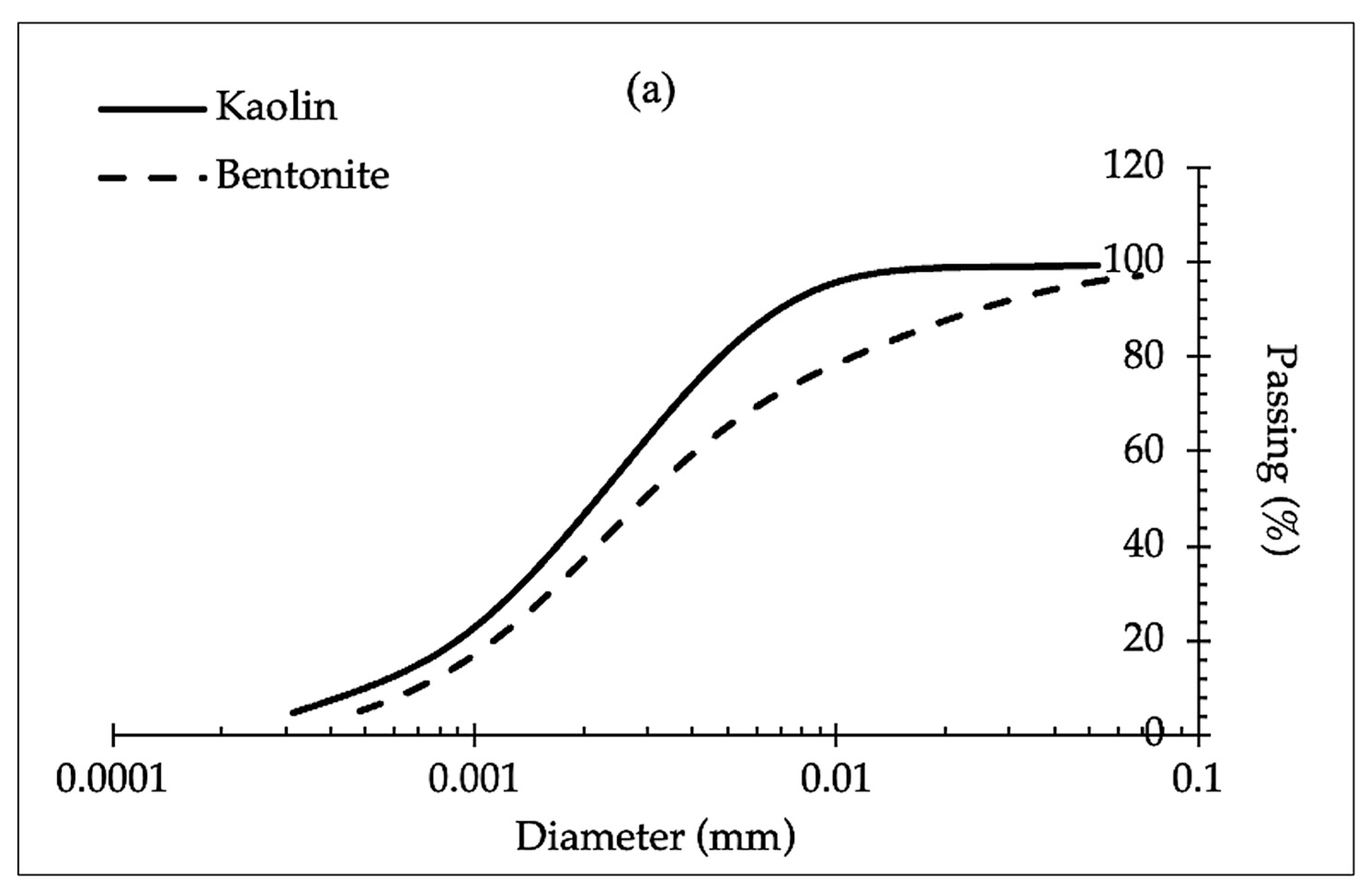
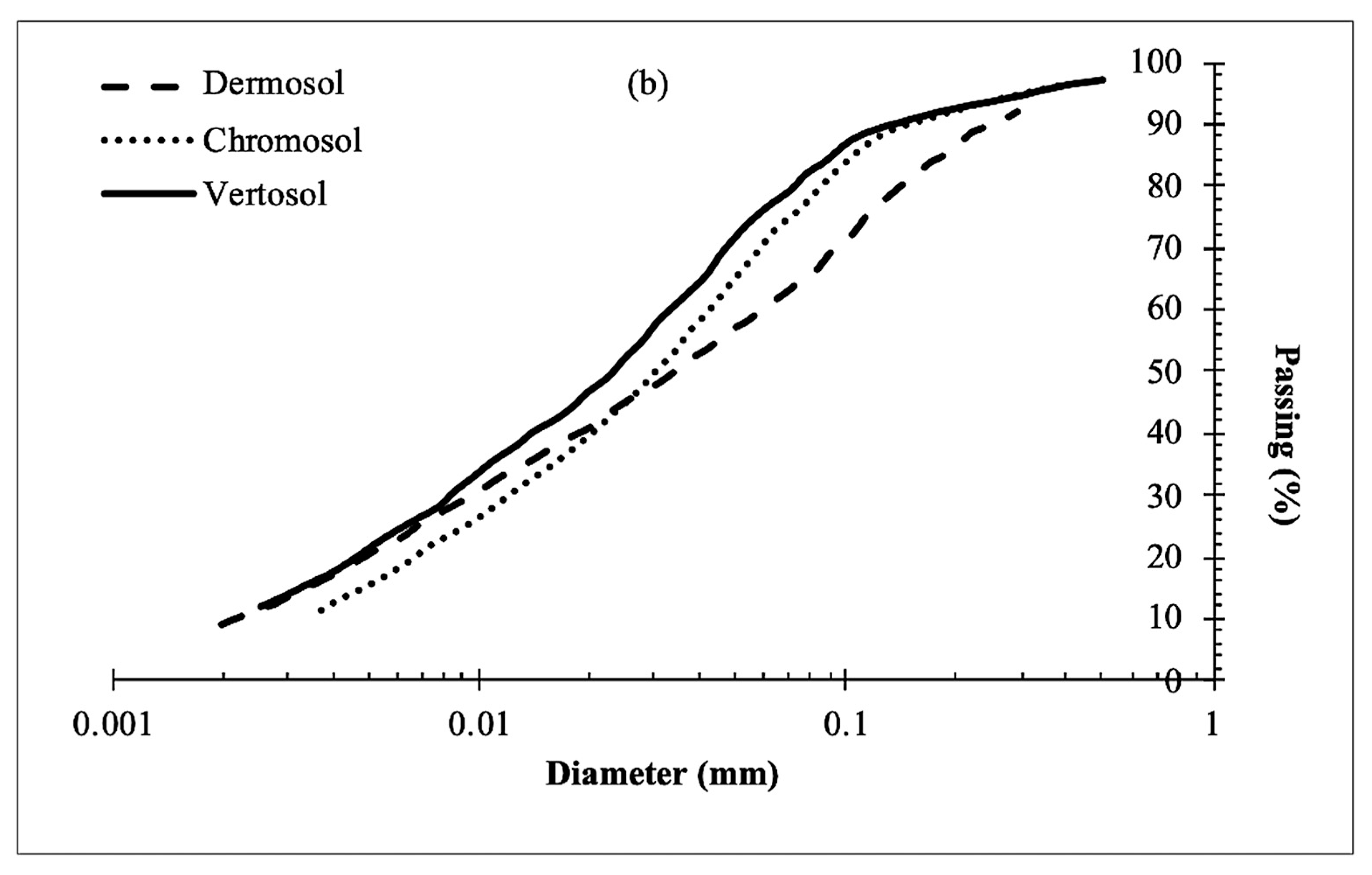
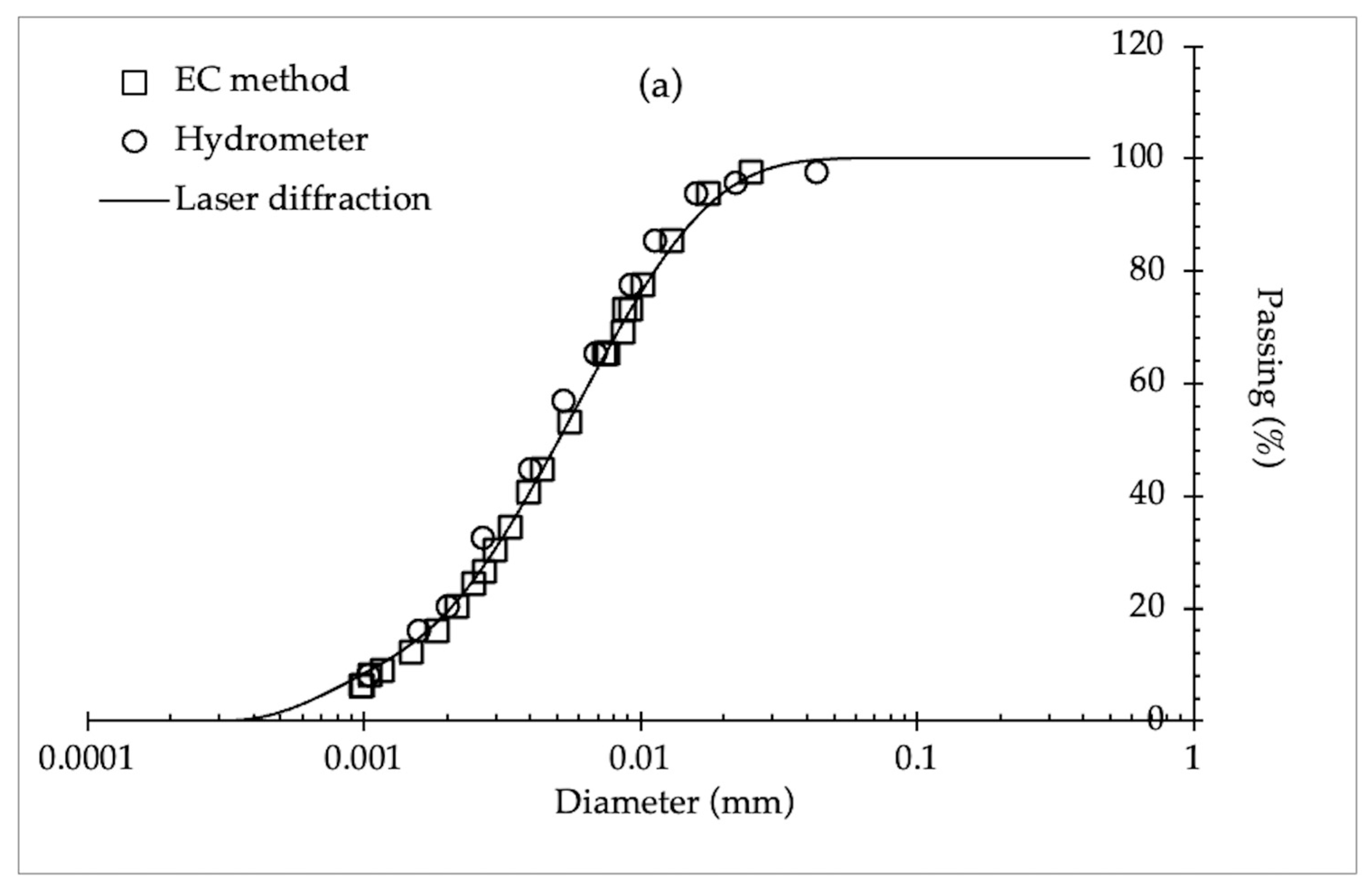
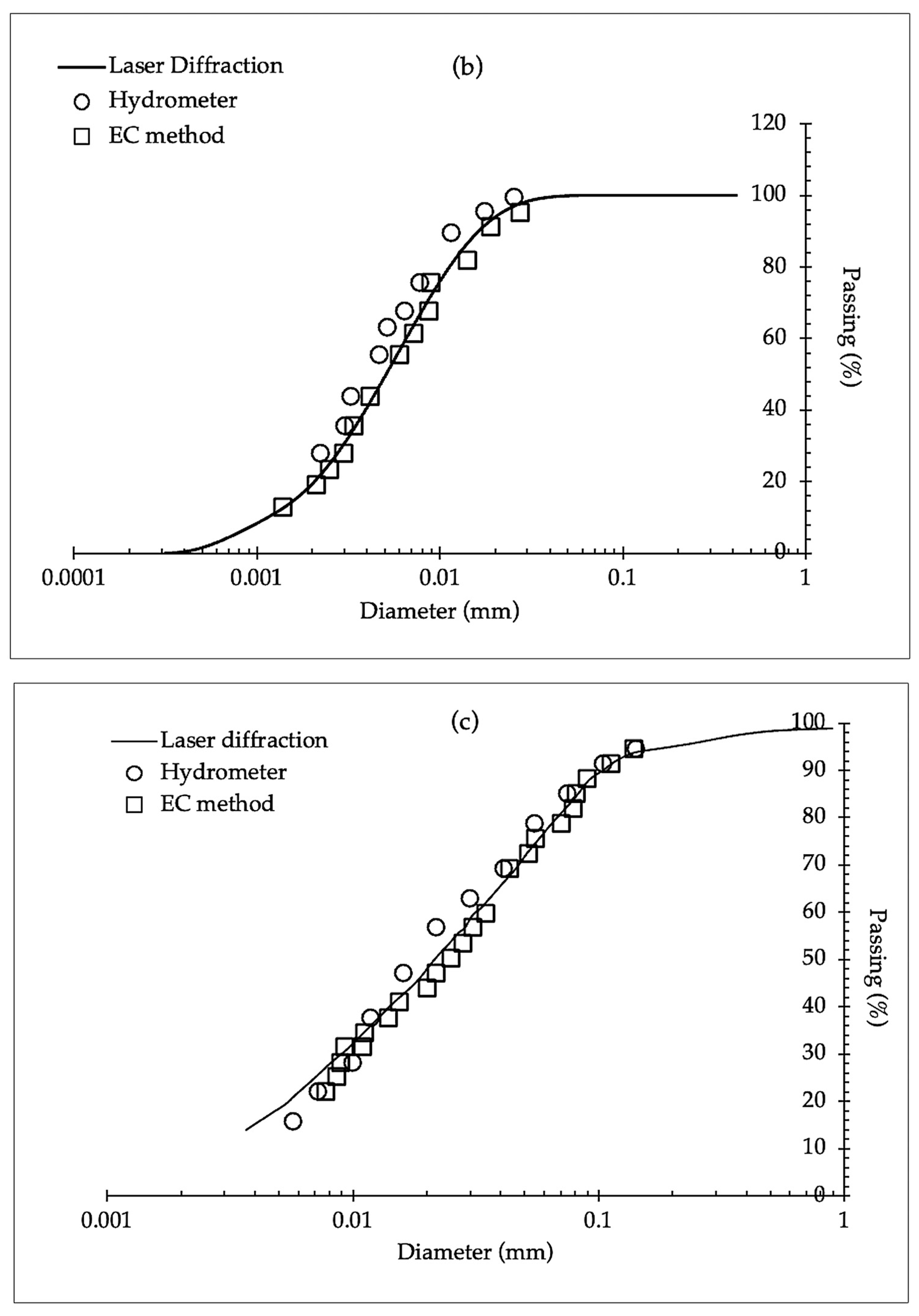

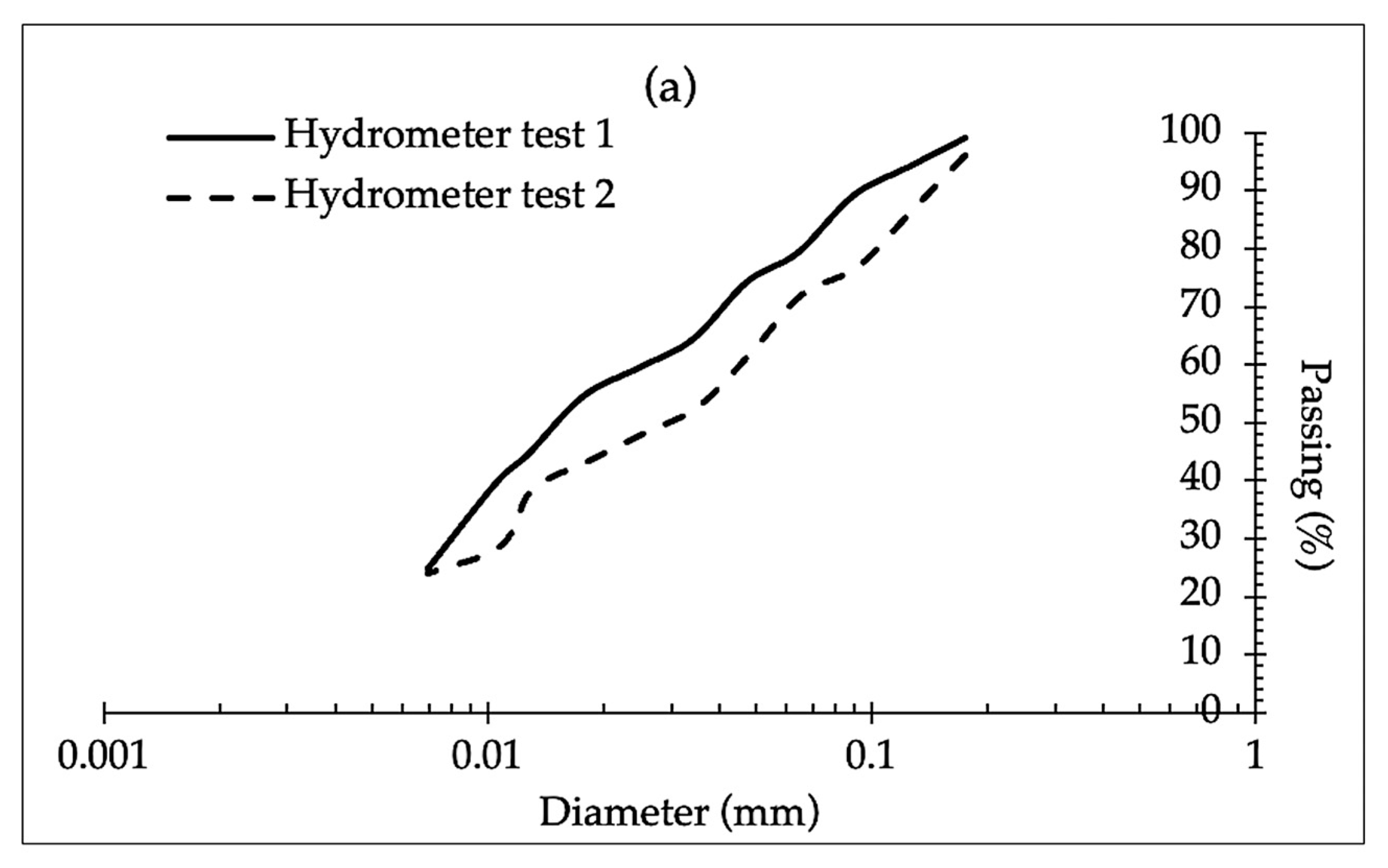
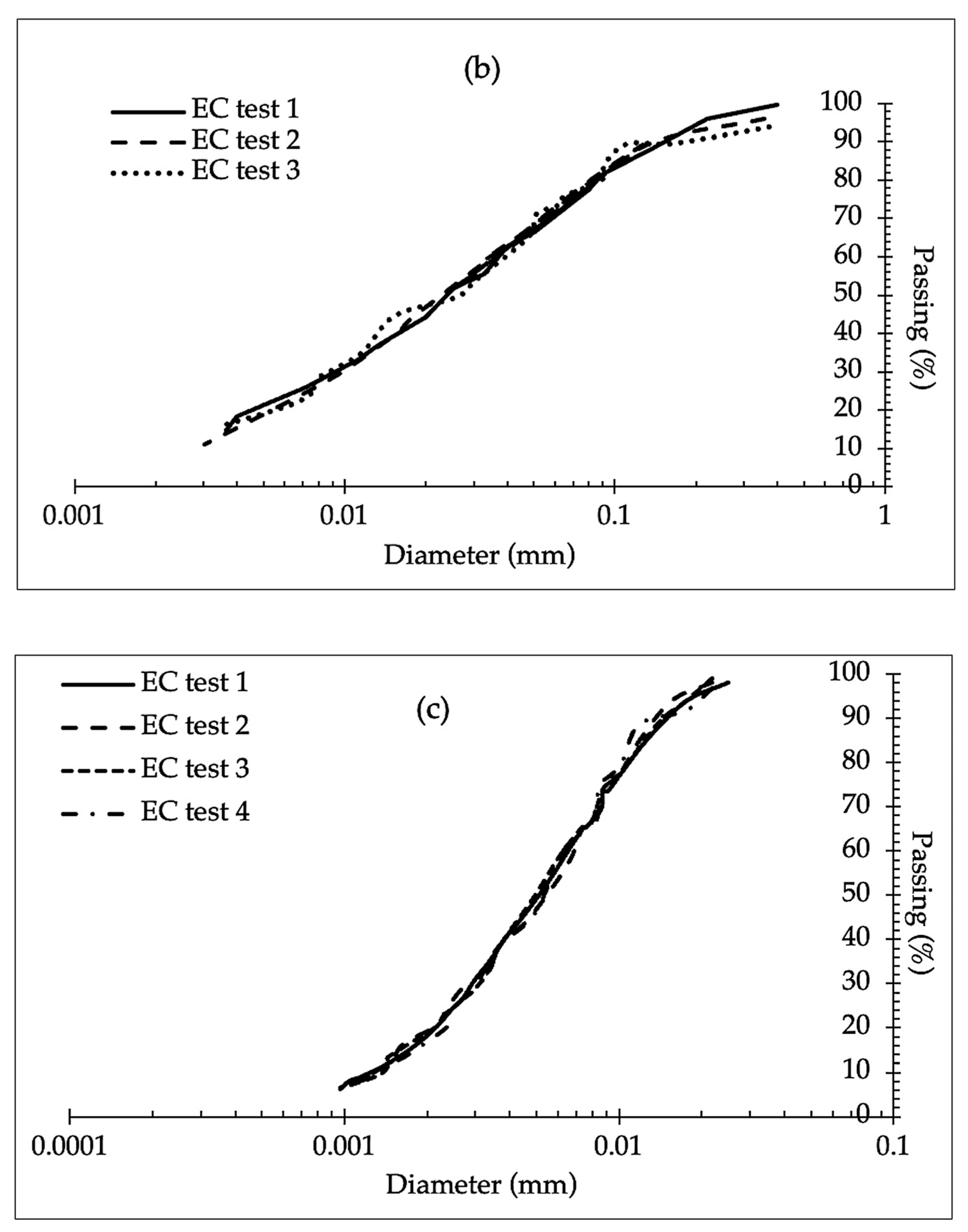
| Properties | Kaolin | Bentonite | Dermosol | Chromosol | Vertosol |
|---|---|---|---|---|---|
| Liquid Limit (%) | 74 | 504 | 59 | 58 | 49 |
| Plastic Limit (%) | 32 | 53 | 29 | 27 | 28 |
| Specific gravity (Gs) | 2.58 | 2.68 | 2.6 | 2.59 | 2.68 |
| pH in water (28%–40% solid) | 7 | 9.5 | 5.17 | 5.5 | 7.1 |
| Cation Exchange Capacity (meq/100 g) | 0.075 | 80 | 2.9 | 4.5 | 20 |
| Type of Properties | Information |
|---|---|
| Chemical formula | Na6O18P6 |
| Molecular weight | 611.77 |
| Appearance | White crystals |
| Density (g/cm3) | 2.484 |
| pH in water | 8.2 |
| Sample | Benchmark | Particle Type | R2 | LCCC |
|---|---|---|---|---|
| Kaolin | Laser diffraction | Clay | 0.97 | 0.86 |
| Silt | 0.99 | 0.97 | ||
| Sand | 0.99 | 0.97 | ||
| Hydrometer | Clay | 0.80 | 0.96 | |
| Silt | 0.87 | 0.85 | ||
| Sand | 0.99 | 0.97 | ||
| Bentonite | Laser diffraction | Clay | 0.97 | 0.73 |
| Silt | 0.97 | 0.81 | ||
| Sand | 0.99 | 0.94 | ||
| Hydrometer | Clay | 0.99 | 0.95 | |
| Silt | 0.98 | 0.98 | ||
| Sand | 0.98 | 0.82 | ||
| Vertosol | Laser diffraction | Clay | - | - |
| Silt | 0.99 | 0.99 | ||
| Sand | 0.98 | 0.88 | ||
| Hydrometer | Clay | - | - | |
| Silt | - | - | ||
| Sand | 0.98 | 0.98 | ||
| Dermosol | Laser diffraction | Clay | - | - |
| Silt | 0.94 | 0.86 | ||
| Sand | 0.97 | 0.93 | ||
| Hydrometer | Clay | - | - | |
| Silt | - | - | ||
| Sand | 0.98 | 0.97 | ||
| Chromosol | Laser diffraction | Clay | - | - |
| Silt | - | - | ||
| Sand | 0.99 | 0.98 | ||
| Hydrometer | Clay | - | - | |
| Silt | - | - | ||
| Sand | 0.94 | 0.81 |
Disclaimer/Publisher’s Note: The statements, opinions and data contained in all publications are solely those of the individual author(s) and contributor(s) and not of MDPI and/or the editor(s). MDPI and/or the editor(s) disclaim responsibility for any injury to people or property resulting from any ideas, methods, instructions or products referred to in the content. |
© 2024 by the authors. Licensee MDPI, Basel, Switzerland. This article is an open access article distributed under the terms and conditions of the Creative Commons Attribution (CC BY) license (https://creativecommons.org/licenses/by/4.0/).
Share and Cite
Hasan, M.F.; Abuel-Naga, H. An Alternative Method of Obtaining the Particle Size Distribution of Soils by Electrical Conductivity. Minerals 2024, 14, 804. https://doi.org/10.3390/min14080804
Hasan MF, Abuel-Naga H. An Alternative Method of Obtaining the Particle Size Distribution of Soils by Electrical Conductivity. Minerals. 2024; 14(8):804. https://doi.org/10.3390/min14080804
Chicago/Turabian StyleHasan, Md Farhad, and Hossam Abuel-Naga. 2024. "An Alternative Method of Obtaining the Particle Size Distribution of Soils by Electrical Conductivity" Minerals 14, no. 8: 804. https://doi.org/10.3390/min14080804
APA StyleHasan, M. F., & Abuel-Naga, H. (2024). An Alternative Method of Obtaining the Particle Size Distribution of Soils by Electrical Conductivity. Minerals, 14(8), 804. https://doi.org/10.3390/min14080804







